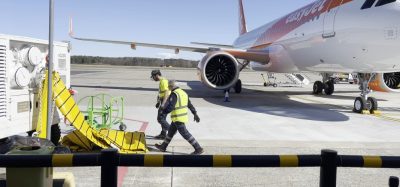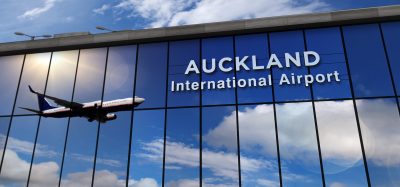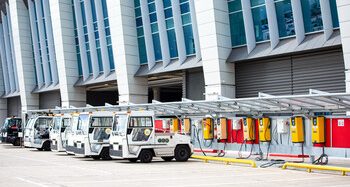Ground level coordination
- Like
- Digg
- Del
- Tumblr
- VKontakte
- Buffer
- Love This
- Odnoklassniki
- Meneame
- Blogger
- Amazon
- Yahoo Mail
- Gmail
- AOL
- Newsvine
- HackerNews
- Evernote
- MySpace
- Mail.ru
- Viadeo
- Line
- Comments
- Yummly
- SMS
- Viber
- Telegram
- Subscribe
- Skype
- Facebook Messenger
- Kakao
- LiveJournal
- Yammer
- Edgar
- Fintel
- Mix
- Instapaper
- Copy Link
Posted: 25 November 2005 | Ben Sampson | No comments yet
The state of play on the ramps and aprons of the world’s airports reflects the state of the industry in general, airline efficiency and advances in technology.
The state of play on the ramps and aprons of the world’s airports reflects the state of the industry in general, airline efficiency and advances in technology.
Ground handling plays a vital role in the operation of an airport. Even though an increasing number of airports throughout the globe are looking to sources of revenue separate from aeronautical ones, the turnaround of aircraft with passengers and cargo remains a core market. There is little surprise then that attention in the industry focuses on the safe and efficient turnaround of aircraft at the apron. What are the factors that influence the operational environment, and how can one be sure that regulations are met as well as targets?
Industry pressures
Airlines are losing money. From 2001 to 2004 IATA reports these losses to amount to US$ 36 billion, with a loss of US$ 7.4 billion expected this year. “Our US$ 97 billion fuel bill is robbing our profitability. Fuel is now 25 percent of our operating costs, up from 14 percent in 2003,” said IATA chairman Giovanni Bisignani at the recent IATA e-freight conference in Geneva. This cost can be mitigated by airlines through fuel surcharges, high load factors and efficiency gains only for a certain amount of time, before the limit is hit and a trade-off with demand has to happen, said Bisignani.
Meanwhile many airports have reported profits this year. In Europe Fraport, which owns and manages Frankfurt Airport, experienced a profit increase of more than 18.4 percent compared to 2003, with total group profits of 136.4 million Euros in 2004. UK-based BAA posted profits of US$ 1.17 billon for the year ending April 2005, an increase of 18.8 per cent over 2004. Away from Europe, Malaysia Airports reported a 50 per cent rise in profits and Auckland Airport a 20 per cent rise.
Passenger numbers continue to increase year on year, and forecasts from IATA predict a stable growth rate of 5.6 percent between 2005 and 2009. Demand for services then is increasing, but issues are faced by airlines on the cost and supply side of the equation. Little surprise then that this is reflected by an emphasis in airports by handlers on the efficiency and quality of service provided to its customers.
Quality and Safety standards
Quality and safety considerations are also at the forefront of considerations on the ramp. A joint statement from ACI Europe and the European Transport Workers Federation published earlier this year highlights concerns over both in the ground handling sector in Europe. As a result of market liberalisation, states the report, several airport operators have reported a loss of control over the quality of handling services. A drop in quality not only affects passengers, other airlines and the functioning of the entire airport, it also impacts negatively on the image of the airport.
Furthermore safety standards, the statement reports, are paramount. Safety is compulsory and defined by ICAO regulations through IATA AHM standards. Regardless of whether the handling agent is an airline, airport or handler, an assessment of safety should be conducted. An implication of the opening up of markets within the EU has been an increased turn over of staff, the statement notes. This may have safety implications, for example where the sub-contracting of ground handling activities is uncontrolled. In the European Union, safety standards according to IATA AHM and / or JAR-OPS must be ensured by member states.
Efficiency and effectiveness and sufficient training are concepts, but events and operations all take place on the ground in real-time. Placing effective management and control in the hands of ground handling supervisors and managers is therefore imperative; managing resources, co-ordinating staff and ensuring adequate training in a dynamic environment can be a challenge. Improvements in communications and IT can assist in these efforts.
Managing vehicles
A busy airfield will contain many different vehicles with different operational aims at any time, which all need to be managed. Amicus is currently offering its Vehicle Management System (VMS) to help manage GSE. The system uses telematics to ensure full utilisation of vehicles and GSE, and to minimise lost revenue brought about by accidents. It also allows information such as the driver’s identity, exact vehicle location and speed to be easily determined.
John Bradshaw, from Amicus, says that current fleet management solutions have so far been impractical for the airport industry because of high implementation costs, high airtime charges and limited reporting facilities. “Amicus VMS,” he says, “represents one of the most technologically advanced and affordable vehicle airport telematics solutions available. Its ease of use and access to management report information makes it possible for all Airport operators to benefit.”
Regarding safety, there are a number of advantages that the use of vehicle tracking enables. Direct benefits, says John, are the recovery of revenues lost through accident damage. “These concerns are as important as operational factors such as knowing exactly who was driving a vehicle, its speed, location and ancillary connections, such as Oil warning lights or door switches,” he says. “These factors are crucial in reducing vehicle down time and prolonging vehicle longevity.”
Managing resources
Of course, vehicles aren’t the only asset on the airfield. One of the most important resources, people, can also be managed with increased efficiency, effectiveness and improved safety with new technology. Such a solution is offered by Workbridge.
“The WorkBridge platform deals with Ground Resource Management,” says Christian Møller from Workbridge. “That is to better plan and utilise the resources that deliver all the ground work around the Aircraft. Services could be passenger services, ramp operations, cleaning, catering, fuelling… etc.”
There are two aspects of the software solution offered by the company which help organisations dealing with large workforces: long term planning and real-time scheduling. The former is designed to assist with long term planning, to help identify resource needs based on new contracts or changes in the flight schedules. The latter, real time scheduling, is intended to assist on the day of operation by supporting automated resource allocation, scheduling and dispatching minute-by-minute changes in the flight status and the working teams.
The system supports the use of handheld mobile devices to deliver and capture information at the source with the ground crews. The software, says Christian, has provided benefits for customers in the airport industry already.
“Based on benchmarks in London Heathrow and Gatwick airports, with the use of our software, our customers have been able to reduce labour costs between 5-10 percent”, says Christian. They have also been able to increase revenue by 1-2 percent through using electronic registration of all services and reduce the number of delays by 50 percent due to better pro-active operational control using hand-held devices.
Furthermore, according to Christian, the Workbridge software enables service providers in an airport to avoid any safety issues at the first point by being in control of the operation. “Our software is all about that – the operational real-time system will know at any given point in time; who is where, doing what and what they are supposed to do next.” The use of the handheld devices also gives workers on the field a flight schedule in the palm of their hand, ensuring they know aircraft movements.

















